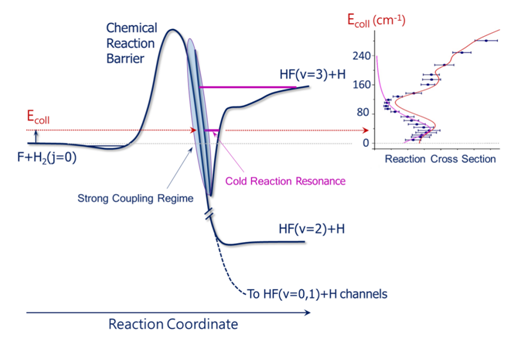SUSTech chemists published a perspective article about “quantum resonances near absolute zero” in Science
2020-05-10
Two recent advances in “quantum resonances near absolute zero,” have sought to prove quantum mechanics in atomic and molecular collisions through experimentation, especially at temperatures near absolute zero Kelvin (K). Southern University of Science and Technology (SUSTech) chemists have provided their viewpoint on these ground-breaking achievements.
Professors Tiangang Yang and Xueming Yang (Department of Chemistry) were invited to publish a perspective article entitled “Quantum resonances near absolute zero,” in the most recent issue of the high-impact academic journal, Science (IF = 41.037).
It is well established that the rules of quantum mechanics govern all atomic and molecular collision processes. It is, therefore, essential to understand the quantum nature of atomic and molecular collisions to gain an insight into energy transfer and chemical reaction processes. This is especially the case in the low collisional energy region, where the quantum effect is the most prominent. A remarkable feature of quantum nature in an atomic and molecular collision is quantum scattering resonances, but proving them through experimentation has been a great challenge due to the transient nature of these resonances.
The perspective article introduced a quantum resonance study published in the same issue of Science by a research group from the Radboud University of Nijmegen, under the title of “Imaging the onset of the resonance regime in low-energy NO-He collisions.” The researchers used the Stark decelerated molecular beam of NO (j=½f) and a cryogenic helium beam combined with a high-resolution velocity map imaging technique. The group of researchers observed resonances in the NO He inelastic collisions at the temperature range of 0.3 to 12.3 K. Accurate quantum dynamics calculations are in excellent agreement with experimental results. What was of particular interest was that the resonances could only be accurately described using a new NO-He potential energy surface (PES) at the CCSDT(Q) level. It demonstrated the exceptionally high accuracy of the resonance picture developed for this benchmark inelastic collision system.
In addition to inelastic scattering processes (discussed above), resonances in chemical reactive collisions in the low collision energy regime were discussed in a paper published in the high impact journal, Nature Chemistry (IF = 23.193). The paper, titled, “Enhanced reactivity of fluorine with para-hydrogen in cold interstellar clouds by resonance-induced quantum tunneling,” looked at the vital benchmark system for reaction resonances. The F H2→HF H reaction is a significant source of HF formation in interstellar clouds (ISC). The F H2 reaction is known to have a significant reaction barrier (629 cm-1). Therefore its reactivity should be negligible at temperatures near absolute zero. Understanding the HF formation mechanism through this reaction at the cold temperatures is essential, which can help to determine hydrogen column density in space.
With the improved molecular crossed beam apparatus, the F reaction and H2 have been studied as low as 14 K (9.8 cm-1) at the State Key Laboratory of Molecular Reaction Dynamics, Dalian Institute of Chemical Physics (DICP) of the Chinese Academy of Sciences (CAS). A clear resonance peak at the collision energy of ~40 cm-1 has been discovered, which is found to be responsible for the enhanced reactivity near absolute zero temperature from the detailed dynamic analysis on an accurate PES. This reaction should have unusually high reactivity at temperatures below 1K, due to the resonance-enhanced quantum tunneling. Further theoretical analysis indicated that if the contribution of the resonance-enhanced tunneling were removed from the reactivity, the reaction rate constant of F H2 below 10K would be reduced more than three orders of magnitude.
 Figure 1. The schematic shows the quasi-bound quantum resonance state in the post barrier region, which is responsible for the enhanced reactivity in the F H2→HF H reaction at a temperature near absolute zero.
Figure 1. The schematic shows the quasi-bound quantum resonance state in the post barrier region, which is responsible for the enhanced reactivity in the F H2→HF H reaction at a temperature near absolute zero.
In this Science Perspective article, the authors pointed out that strong interaction between experiment and theory has been crucial in the study of transient collision resonances. The dynamics studies in atomic and molecular collisions are especially important to understanding energy transfer and chemical reaction processes that could have a profound impact on complicated systems. These systems include terrestrial and planetary atmospheres, interstellar clouds, gas-phase lasers, semiconductor processing, plasmas, and combustion processes.
Assistant Professor Tiangang Yang is the first author, and Academician Xueming Yang is the corresponding author. This work was supported by the National Natural Science Foundation of China, the Chinese Academy of Sciences, and Shenzhen City.
Article link: https://science.sciencemag.org/content/368/6491/582
References:
https://science.sciencemag.org/content/368/6491/626
https://www.nature.com/articles/s41557-019-0280-3




